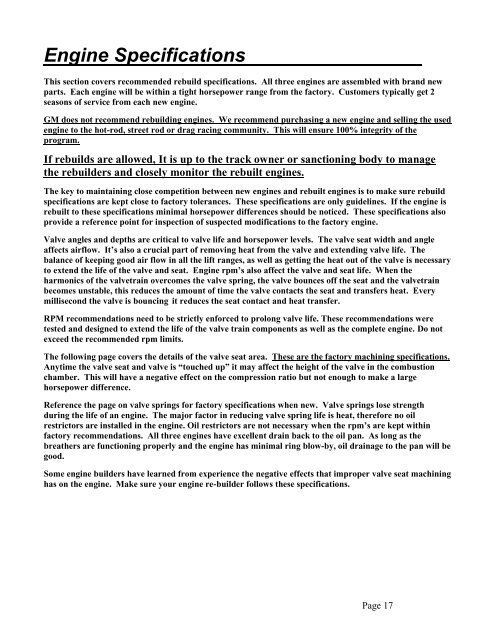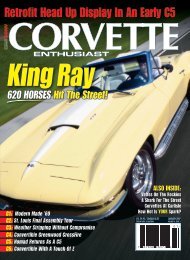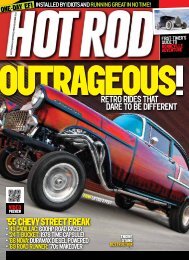Circle Track Crate Engine Technical Manual - Chevrolet Performance
Circle Track Crate Engine Technical Manual - Chevrolet Performance
Circle Track Crate Engine Technical Manual - Chevrolet Performance
You also want an ePaper? Increase the reach of your titles
YUMPU automatically turns print PDFs into web optimized ePapers that Google loves.
<strong>Engine</strong> Specifications<br />
This section covers recommended rebuild specifications. All three engines are assembled with brand new<br />
parts. Each engine will be within a tight horsepower range from the factory. Customers typically get 2<br />
seasons of service from each new engine.<br />
GM does not recommend rebuilding engines. We recommend purchasing a new engine and selling the used<br />
engine to the hot-rod, street rod or drag racing community. This will ensure 100% integrity of the<br />
program.<br />
If rebuilds are allowed, It is up to the track owner or sanctioning body to manage<br />
the rebuilders and closely monitor the rebuilt engines.<br />
The key to maintaining close competition between new engines and rebuilt engines is to make sure rebuild<br />
specifications are kept close to factory tolerances. These specifications are only guidelines. If the engine is<br />
rebuilt to these specifications minimal horsepower differences should be noticed. These specifications also<br />
provide a reference point for inspection of suspected modifications to the factory engine.<br />
Valve angles and depths are critical to valve life and horsepower levels. The valve seat width and angle<br />
affects airflow. It’s also a crucial part of removing heat from the valve and extending valve life. The<br />
balance of keeping good air flow in all the lift ranges, as well as getting the heat out of the valve is necessary<br />
to extend the life of the valve and seat. <strong>Engine</strong> rpm’s also affect the valve and seat life. When the<br />
harmonics of the valvetrain overcomes the valve spring, the valve bounces off the seat and the valvetrain<br />
becomes unstable, this reduces the amount of time the valve contacts the seat and transfers heat. Every<br />
millisecond the valve is bouncing it reduces the seat contact and heat transfer.<br />
RPM recommendations need to be strictly enforced to prolong valve life. These recommendations were<br />
tested and designed to extend the life of the valve train components as well as the complete engine. Do not<br />
exceed the recommended rpm limits.<br />
The following page covers the details of the valve seat area. These are the factory machining specifications.<br />
Anytime the valve seat and valve is “touched up” it may affect the height of the valve in the combustion<br />
chamber. This will have a negative effect on the compression ratio but not enough to make a large<br />
horsepower difference.<br />
Reference the page on valve springs for factory specifications when new. Valve springs lose strength<br />
during the life of an engine. The major factor in reducing valve spring life is heat, therefore no oil<br />
restrictors are installed in the engine. Oil restrictors are not necessary when the rpm’s are kept within<br />
factory recommendations. All three engines have excellent drain back to the oil pan. As long as the<br />
breathers are functioning properly and the engine has minimal ring blow-by, oil drainage to the pan will be<br />
good.<br />
Some engine builders have learned from experience the negative effects that improper valve seat machining<br />
has on the engine. Make sure your engine re-builder follows these specifications.<br />
Page 17




